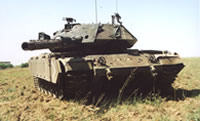A combination of passive and reactive armor was introduced in the 1980s, as more advanced armor solutions were implemented with upgraded and new platforms, such as Leopard-2A6 (below), Challenger 2, Leclerc, Merkava Mk4, Mk3, and IMI Sabra (modernized M-60 version developed by IMI for the Turkish Army Tank Upgrade Program – photo below). Composite armor uses various materials different hardness and elasticity, heat and shock absorbing materials, layered and sandwiched together, to provide improved protection against specific threats, such as multiple-hits of Kinetic Energy (KE), and Chemical Enegry (CE) ammunition.
Composite passive armor is designed to absorb the energy of the impact, and prevent penetration and internal damage by the penetrating projectile or its residual effects. Active and Reactive protection systems are designed to detect and deflect an incoming round or destroy it during the initial phase of the penetration. Deflection of shaped-charge weapons such as rocket-propelled grenades and anti-tank missiles without adding extra weight, as did the current reactive armor system. Composite armor is usually provided in modules or tiles, which are composed of a mosaic of hard (ceramic) materials, soft but strong (composite fibers) embedded in concrete matrixes. The frontal plan is usually covered with softer material, such as rubber or other composites, which are used to dissipate the initial impact and minimize the damage to the internal mosaic, thus retaining its multi-hit protection capability. Typical passive add-on armor is the MEXAS, produced by IBD in Germany. In some models of passive composite armor, reactive, non energetic materials are contained between the different layers of the armor. These materials react when hit by a projectile, and cause the whole module to change its physical characteristics.
Different passive protection was developed for amphibious vehicles. In the 1990s, an enhanced appliqué armor kit (EAAK) was developed by RAFAEL and installed on the USMC Amphibious Assault Vehicles (AAV7A1). This add-on armor retains the vehicle’s floating capability. More advanced add-on protection suits are based on hybrid modules, such as the IMI-RAFAEL L-VAS protection suite for the M-113 and LAV/Stryker APCs. This system is utilizing a hybrid armor solution, comprising of both passive and reactive armor, added with mesh traps, to provide front and side multi-hit protection from RPGs, 14.5mm AP and 155mm shell fragments, at a total weight increase of only two tons. Mesh traps also known as Slat Armor are also deployed on the Stryker Armored Personnel carriers, currently deployed in Iraq. Within a decade, futuristic concepts such as the Future Combat Systems armored elements are expected to field protection systems capable of deflecting large caliber HEAT (High Explosive Anti-Tank) and kinetic munitions (APFSDS).
For Future Combat Systems, planned for deployment in the next decade, the US Army is studying optimized armor configurations, including frontal armor that will weigh 80lb/ft2 which will be capable of defeating medium-caliber automatic cannon threats, shaped-charge threats, and residual threat debris from large-caliber KE intercepted by an Active Protection Systems (APS). Another type of armor, designed for light vehicles, will be able to defeat heavy machine gun threats at 20 lb/ft2. Tests of various candidate designs is expected in 2004.
Further in the future, advanced protection techniques are developed, including stealth, smart armor, which attempts to deflect a round once it has penetrated the first layer of armor, and electromagnetic armor, which deforms and reshapes the penetrating rounds or plasma jet – both methods are causing the projectile’s disintegration inside the armor, by its own kinetic or heat energy. These technologies are expected to mature in time for FCS Block II. The US Army is currently testing electromagnetic armor concepts on the Bradley. The system uses spaced, add-on modular elements, formed with a charged element and a forward surface, used as a precursor. the HEAT jet which penetrates the forward layer discharges the internal layer, and the effect causes the jet to dissipate and loose its energy. The system can be recharged and therefore protect the vehicle from multiple shots. The current version of electromagnetic armor is designed primarily against relatively small (RPG style) threats, but could be upgraded (with more power) to protect against larger HEAT warheads. United Defense, which develops the system under an ARL program, expects that the concept could mature in a few years, if adequate funding is made available for the program.
Additional Parts of this article :
- Protection Systems For Future Armored Vehicles
- Add-On – Reactive Armor Suits
- Advanced Add-on Armor for Light Vehicles
- Active Defense & Countermeasures Soft Kill
- Active Defense & Countermeasures





















